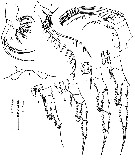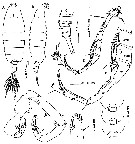|
|
 |
|
Calanoida ( Order ) |
|
|
|
Diaptomoidea ( Superfamily ) |
|
|
|
Tortanidae ( Family ) |
|
|
|
Tortanus ( Genus ) |
|
|
|
Atortus ( Sub-Genus ) |
|
|
| |
Tortanus (Atortus) vietnamicus Nishida & Cho, 2005 (F,M) | |
| | | | | | | Ref.: | | | Nishida & Cho, 2005 (p.224, Descr.F,M, figs.F,M, Rem.) |  issued from : S. Nishida & N. Cho in Crustaceana, 2005, 78 (2). [p.225, Fig.1]. Female (from 12°12.21'N, 109°13.26'E): A-B, habitus (dorsal and lateral, respectively); C, genital complex with spermatophore and coupler (dorsal); D, P5 and genital complex (ventral, showing P5 and genital operculum); E, A1; F, A2; G, Md (mandibular palp); H, Md (gnathobase). Nota : Prosome about 3.3 times as long as urosome. Cephalosome and 1st pediger separate, 4th and 5th fused. 5th pediger asymmetrical, right posterior corner produced slightly more posteriorly than left, extending to mid-length of genital somite Urosome 2-segmented ; 2nd urosomite completely coalesced with caudal rami Genital compound somite about 1.5 times as long as wide with right anterolateral margin slightly swollen in dorsal view. ; genital operculum semicircular, located ventrally at anterior 1/3 of genital compound somite. Three paratypes have transparent coupling device with left vane larger than right ; anterior margin of vanes fitting protuberances of fifth pediger, posterior margins extending beyond posterior end of caudal rami ; two of these specimens also have a sausage-like spermatohore. A1 symmetrical, reaching mid-length of caudal ramus. Ancestral segments I-IX, XI-XIV, XXVI-XXVIII fused. A2 : Coxa without seta ; basis with medial seta ; basis and endopod completely fused ; endopod 3-segmented, proximal segment with distomedial seta and distolateral row of spinules, 2nd and distal segments incompletely fused ; exopod 3-segmented, proximal segment short and unarmed, middle and distal segment incompletely fused with 3 and 2 setae, respectively. Md : gnathobase with 5 cusped teeth, 2 ventralmost teeth with articulated tip, ventralmost tooth monocuspidate while remaining 4 teeth bicuspidate, 3 dorsalmost teeth with 4 longitudinal spinule rows proximally ; basis elongate and unarmed ; endopod 2 segmented, distal segment with 6 setae ; exopod with 5 setae. Caudal rami asymmetrical with left ramus slightly longer than right.
|
 issued from : S. Nishida & N. Cho in Crustaceana, 2005, 78 (2). [p.226, Fig.2]. Female: A, Mx1; B, Mx2; C, Mxp; D, P1 (anterior view); E, P2 (anterior); F, P3 (anterior); G, P4 (anterior); H, P5 (anterior). Nota : Mx1 : Basis and rami completely absent ; praecoxal arthrite with 12 spinulose setae and 1 minute seta ; coxal endite with 3 stout, spinulose terminal setae. Mx2 : Syncoxal endites with 1, 2, 2, and 3 setae from proximal to dista ; basal endite wit 1 developed and 2 rudimentary setae ; endopod with 5 stout setae with claw-like tip and 2 rudimentary setae. Mxp : Syncoxa with 2 endites, each with spinulose seta ; basis unarmed ; endopod with 3 medial spinulose setae and lateral seta. Basis of P1 with 1 minute outer seta. P5 uniramous, 2-segmented, symmetrical with basis of right and left legs fused ; ramus trapezoid, with distal margin broader, with distolateral seta.
|
 issued from : S. Nishida & N. Cho in Crustaceana, 2005, 78 (2). [p.228]. Seta (Arabic numbers) and spine (Roman numbers) fomula of swimming legs of females. Appendages of male similar those of female.
|
 issued from : S. Nishida & N. Cho in Crustaceana, 2005, 78 (2). [p.227, Fig.3]. Male: A-B, habitus (dorsal and lateral, respectively); C, urosome (right lateral view); D, right A1; E, right A1 (Roman numerals denote ancestral-segment numbers); F, P5 (anterior view); G, left P5 (tip of distal exopod); H, pediger 5 and urosomite 1 from 3 specimens (dorsal view), showing asymmetry of pediger 5 with left side slightly more acute and posteriorly produced than right. Nota : Prosome about 2.8 times as long as urosome. Posterior corners of 5th pediger rounded and asymmetrical, with left posterior margin slightly more acute and produced more posteriorly than right. Urosome 5-segmented. Proportional lengths of urosomites and caudal ramus 18 : 16 : 15 : 14 : 13 : 24 = 100. Genital somite with genital aperture on left posterolateral margin ; 2nd urosomite with posterolateral and posteroventral processes on right side, of which the latter smaller, each with minute seta on tip. Caudal rami symmetrical. Appendages similar to those of female except right A1 and P5. Right A1 geniculate ; ancestral segments I-VIII, XXI-XXIII, XXIV-XXVIII completely or incompletely fused ; segments XV-XIX expanded.
| | | | | NZ: | 1 | | |
|
Distribution map of Tortanus (Atortus) vietnamicus by geographical zones
|
| | | | | | | Loc: | | | Vietnam (Nha Trang) | | | | N: | 1 | | | | Lg.: | | | (962) F: 2,12-2,22; M: 1,82-1,95; {F: 2,12-2,22; M: 1,82-1,95} | | | | Rem.: | Inshore. Collected from near the bottom to the surface (depth ± 2 m).
For Nishida & Cho (2005, p.229) the new species belongs to the tropicus species complex within the subgenus Atortus Ohtsuka, 1992.
While Ohtsuka & Kimoto (1989) proposed the name ‘’brevipes species complex’’ for this assemblage of species, the name ‘’tropicus’’ proposed by Othman (1987) is maintened, since the male of T. brevipes has not yet been described.
This species complex is defined by the combination of the following characters : 1- the second urosomite of the male with a process on the right side ; 2- the anterior end of the serrate margin of the ancestral segment XX on right A1 of the male produced proximally over segment XIX ; 3- the distal segment of P5 of the female either slender and asymmetrical or subquadrate. The female of T. vietnamicus is distinguished from the other members of the tropicus species complex, except T. brevipes and T. tropicus, by the asymmetrical 5th pediger with the right posterior corner produced more posteriorly than the left.
| | | Last update : 01/02/2015 | |
|
|
 Any use of this site for a publication will be mentioned with the following reference : Any use of this site for a publication will be mentioned with the following reference :
Razouls C., Desreumaux N., Kouwenberg J. and de Bovée F., 2005-2025. - Biodiversity of Marine Planktonic Copepods (morphology, geographical distribution and biological data). Sorbonne University, CNRS. Available at http://copepodes.obs-banyuls.fr/en [Accessed December 13, 2025] © copyright 2005-2025 Sorbonne University, CNRS
|
|
 |
 |






